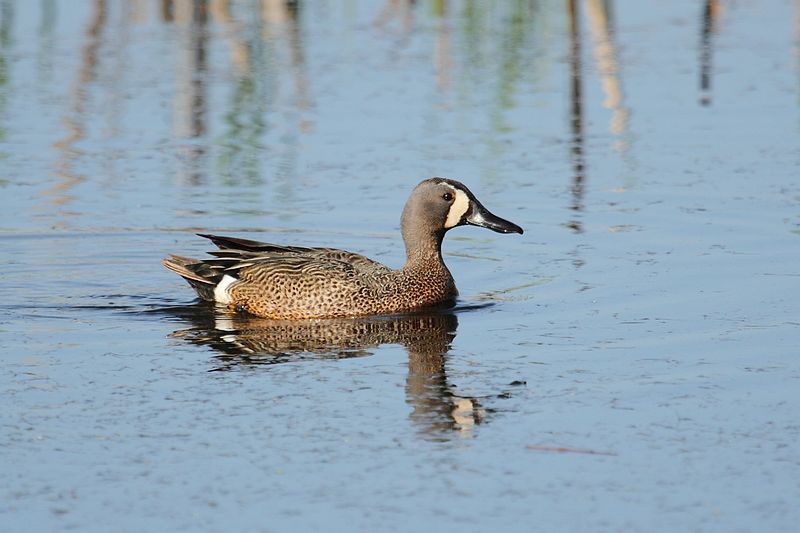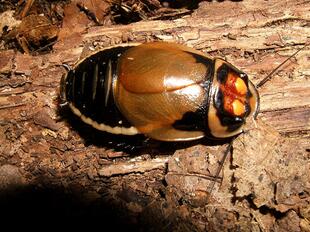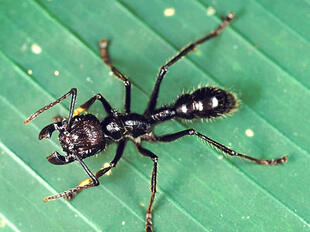
Blue-winged teal(Anas discors)
Phylum —chordata
Class — aves
Order — anseriformes
Family — anatidae
Genus –anas
Appearance
The blue-winged teal is 40 cm (16 in) long, with a wingspan of 58 cm (23 in), and a weight of 370 g (13 oz).
The adult male has a greyish blue head with a white facial crescent, a light brown body with a white patch near the rear and a black tail. The adult female is mottled brown, and has a whitish area at base of bill. Both sexes have sky-blue wing coverts, a green speculum, and yellow legs. They have two molts per year and a third molt in their first year.
Habitat
During the summer months, blue-winged teal can be found throughout North America, from southeastern Alaska (western limit) to the Atlantic coast (eastern limit). They are also found in the continental U.S. in the Great Plains as far south as the Gulf Coast of Texas and Louisiana. In the winter months they migrate southwards to the Carolinas, southern California, and New Mexico and into tropical South America. These ducks breed in southern Alaska and western Canada and south to northwestern California, New Mexico, and New York.
Behavior
Blue-winged teals are highly gregarious, tending to move in or form a group with others of the same species. The only time they are not social is during breeding season. Blue-winged teals migrate between wintering and breeding ranges each year.
They are active during the day. Blue-winged teal can walk well on land and in shallow water. They are not known for climbing, but they often rest and preen on logs and rocks that are slightly above water. They can gain flight directly from land or water. The only time a blue-wing teal will dive in the water is if threatened by a predator or when trying to escape copulation attempts. Blue-winged teals use preening, head-scratching, and stretching of the body to self-clean.
Diet
Blue-winged teals consume a variety of aquatic invertebrates, including insects, crustaceans, snails, and small clams, and aquatic vegetation, including seeds. When females are breeding they require a diet higher in protein, so they eat more invertebrates and seeds.
Reproduction
Blue-winged teals are seasonally monogamous. Pairs usually form on wintering grounds and during spring migration. Most female are paired when they arrive on breeding grounds. A group of males will court one female. Males swim after females and perform a variety of courtship displays. Usually, courtship begins in flight, when males call and pursue females in an erratic flight. A typical on-water display would be: a male swims in front of a female and with his body at an angle to her line of her movement, but his head is up so that the bill points away from the female. The female accepts a male by stretching her head outward. Then her head is lowered and her bill is pointed toward the male. They both perform a head pump.
Blue-winged teals nest from late April through early May. Females lay 6 to 14 eggs, which take 21 to 40 days to hatch. Young reach the fledgling stage at about 24 days and are independent after 40 days.
Females are in charge of nest maintenance and rearing the young, males play no apparent part.
Blue-winged teal that do survive to adulthood can live up to 17 years.
In captivity
In summer, teals are kept in outdoor enclosures. The minimum size of the enclosure is 3 square meters.
In winter, they should be transferred to an insulated enclosure with a temperature of at least +5 °C. However, blue-winged tealscan easily live at cold temperatures (up to -7 °C), and in areas where winter temperatures do not fall below -8 °C, they can be kept outdoors all year round. It is desirable to equip the enclosure with additives in the form of branches and perches. In the winter room, you must install a pool with running or frequently replaced water. In areas with mild winters, blue-winged tealscan be kept in outdoor enclosures.
In this case, all winter it is necessary to maintain a sufficient mirror of the reservoir for birds, not covered with ice. This is achieved in various ways, one of which may be the use of an air compressor. Long hoses from the compressor that pumps air are lowered to the bottom of the reservoir, and air bubbles, rising up, carry warmer water. With constant mixing of warm water from the lower layers of the reservoir with colder water from the surface, the possibility of ice formation is eliminated even in the most severe frosts.
As a winter bedding for waterfowl, you can use soft hay, which is laid out in places where birds rest.
The diet includes grain feed-corn, wheat, barley, millet, oatmeal, wheat bran, grass, meat and fish meal, chalk, small shell, gammarus. In the warm season, it is good to give various greens - cut dandelion leaves, lettuce, plantain, duckweed. Good food for ducks - wet mixtureof grated carrots, bran, various cereals. During the reproductive period and during molting, they are mixed with wet foodor given separately: fish and minced meat. During working out a diet it should be calculated that the amount of raw protein does not exceed 18-19%.
Blue-winged tealsare friendly to other birds, so they can be kept on the same pond with other ducks.
Artificial shelters for nests are installed in the paddock. Ducks independently incubate, breed and raise young ducklings.
 Russian
Russian
 English
English
























